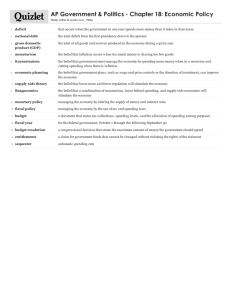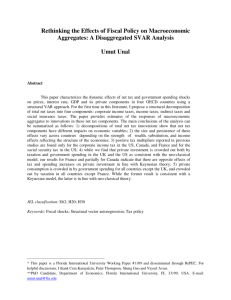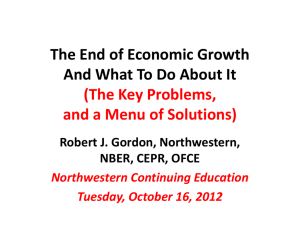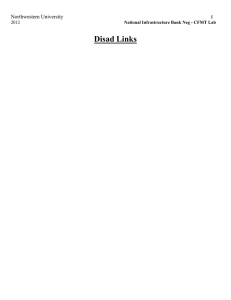AP Gov Ch. 18 LATEST
advertisement
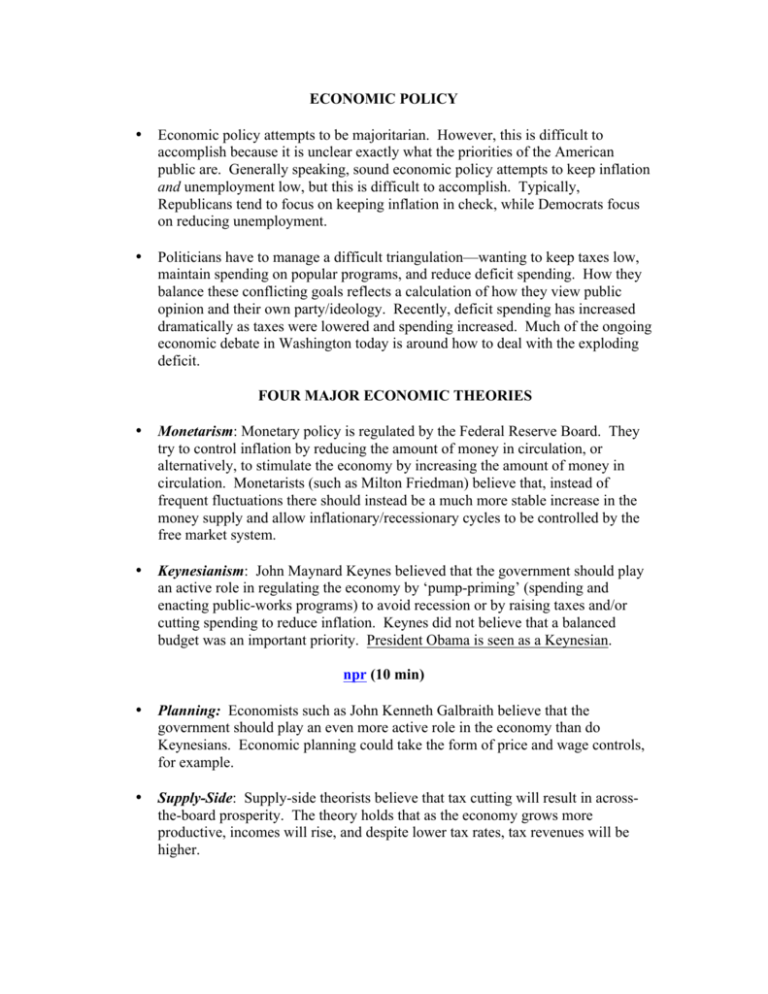
ECONOMIC POLICY • Economic policy attempts to be majoritarian. However, this is difficult to accomplish because it is unclear exactly what the priorities of the American public are. Generally speaking, sound economic policy attempts to keep inflation and unemployment low, but this is difficult to accomplish. Typically, Republicans tend to focus on keeping inflation in check, while Democrats focus on reducing unemployment. • Politicians have to manage a difficult triangulation—wanting to keep taxes low, maintain spending on popular programs, and reduce deficit spending. How they balance these conflicting goals reflects a calculation of how they view public opinion and their own party/ideology. Recently, deficit spending has increased dramatically as taxes were lowered and spending increased. Much of the ongoing economic debate in Washington today is around how to deal with the exploding deficit. FOUR MAJOR ECONOMIC THEORIES • Monetarism: Monetary policy is regulated by the Federal Reserve Board. They try to control inflation by reducing the amount of money in circulation, or alternatively, to stimulate the economy by increasing the amount of money in circulation. Monetarists (such as Milton Friedman) believe that, instead of frequent fluctuations there should instead be a much more stable increase in the money supply and allow inflationary/recessionary cycles to be controlled by the free market system. • Keynesianism: John Maynard Keynes believed that the government should play an active role in regulating the economy by ‘pump-priming’ (spending and enacting public-works programs) to avoid recession or by raising taxes and/or cutting spending to reduce inflation. Keynes did not believe that a balanced budget was an important priority. President Obama is seen as a Keynesian. npr (10 min) • Planning: Economists such as John Kenneth Galbraith believe that the government should play an even more active role in the economy than do Keynesians. Economic planning could take the form of price and wage controls, for example. • Supply-Side: Supply-side theorists believe that tax cutting will result in acrossthe-board prosperity. The theory holds that as the economy grows more productive, incomes will rise, and despite lower tax rates, tax revenues will be higher. In practice, most economic policies are a combination or modification of these four approaches. However, it is typically true that conservatives/Republicans favor monetarism or supply-side policies, while liberals/Democrats tend to be Keynesian or economic planners. “Reaganomics” is a good example of economic policy combination. Under President Reagan, the government adopted several seemingly contradictory policies: supply-side tax cuts, reduced monetary supply (monetarism), and increased spending (particularly on defense programs). The result? A Keynesian economic stimulus! (Low unemployment, huge deficits). The ‘Machinery’ of Economic Policy Making The President’s advisors: • • The “troika”: chairman of the Council of Economic Advisors (professional economists, typically favoring reliance on the market); the director of the Office of Management and Budget (OMB); and the secretary of the Treasury (typically drawn from the business world and representing the views of the business community). • Today, President Obama also has a fourth very influential economic advisor: Jeffrey Zients, who is the Director of the National Economic Council and Assistant to the President for Economic Policy. • Obama’s team, then, consists of: Jason Furman (chair of the CEA); Zients; Sylvia Mathews Burwell (director of the OMB); and Treasury Secretary Jack Lew. In addition to these members of the White House Staff, the Chairman of the Federal Reserve Board (“The Fed”) is another key player in shaping economic policy, as the Fed is responsible for setting monetary policy. President Obama appointed Fed Chairman Janet Yellen just a few months ago, upon the retirement of prior Fed Chair Ben Bernanke. • While the Fed sets monetary policy (basically, how much money is in circulation), Congress sets fiscal policy (taxing and spending). Within Congress, economic policy is influenced by a variety of committees in both Houses. • This fragmented economic policy apparatus clearly limits the amount of direct control that any president may have over the national economy. The Budget • The budget, covering the fiscal year (October 1 to September 30), spells out how much money the government will spend on its various programs. Because we don’t run a balanced budget, spending is far in excess of anticipated tax revenues. • Once the president submits his budget to Congress, each House is to adopt a budget resolution in order to set a ceiling for spending for the year. Currently, the House has passed its budget resolution but the Senate has not, and there is growing controversy over how the resolution is to be passed (see article). • Despite several attempts (Gramm-Rudman Act, Balanced Budget Act of 1990), deficit spending has become routine—Clinton’s surplus is sometimes referred to as a financial “miracle” (1st surplus since 1969). Not likely to be seen again any time soon! Tax Policy • Tax policy tends to be a combination of majoritarian and client policies— graduated income tax is majoritarian, but the large number of loopholes is the result of client politics. • Typically, tax policy is a compromise: higher rates with more loopholes (deductions), or lower rates with fewer loopholes. The former seems to be client politics, while the latter is more majoritarian. • President Obama has criticized the complexity of the tax code and has established a committee to offer a simplified proposal by the end of the year.

